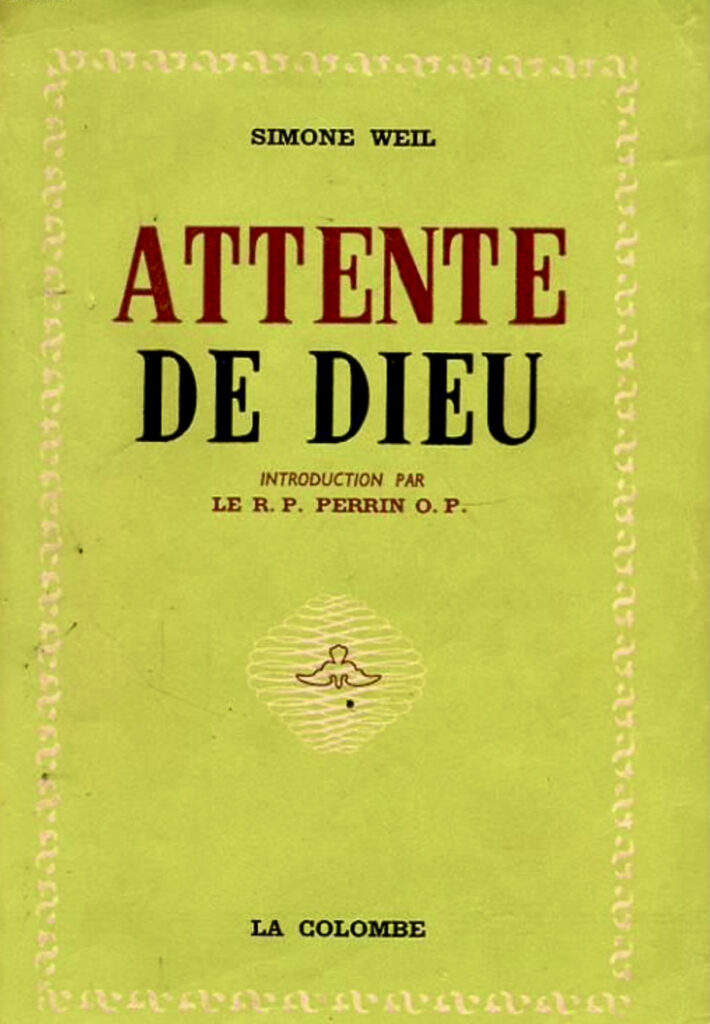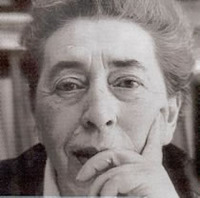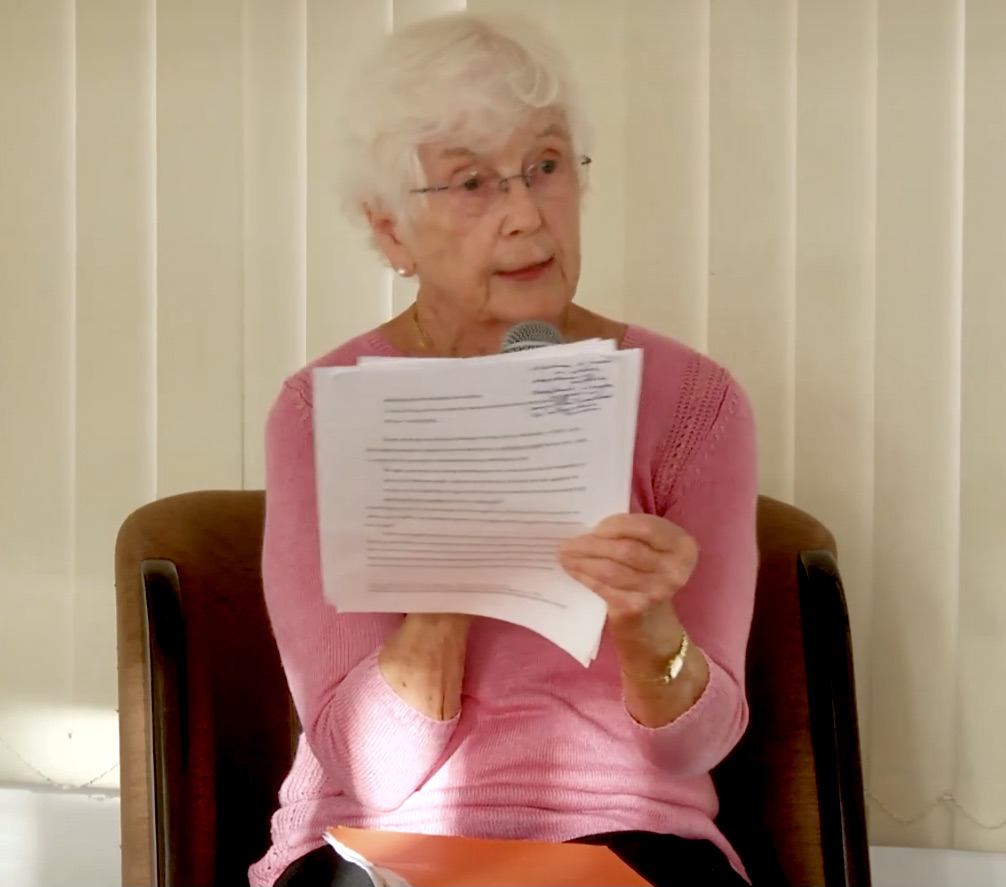A Spiritual Friendship: Simone Weil and Père Perrin
E. Jane DoeringSimone Weil’s letters written to Father Joseph-Marie Perrin o.p reveal her intimate spiritual concerns and witness to the kindred relationship that existed between the almost blind Dominican priest and the young French philosopher intently engaged in a search for Truth. In turn, Perrin’s works describing his young friend’s deep spirituality in the context of her life testify to his love and appreciation for the consistency and devotion of her actions and reflections, notwithstanding certain reservations on his part. What interests us here is the tender note of friendship emanating from his words, particularly in his Introduction (translated by Professor Larry Schmidt) to Waiting for God, a collection of her essays and letters in his possession.

Joseph-Marie Perrin included Simone’s personal letters to him in this collection because they echo their many conversations, and he considered them among the most beautiful of her writings. We owe their existence to the warm friendship, which evolved as they reflected together on past great mystics’ concepts concerning the love of God within Christian and non-Christian religions. The results of their reflections were meant to be shared with others, with encouragement to join the dialogue. On leaving France, Simone left her exposés with him, writing in her last letter: “I see no one but you whom I can implore to give them your attention. I should like you to transfer the charity you have so generously bestowed from me to that which I bear within me, and which I like to think is of far more value than I am myself” (WG, 52).
Parallel to their work on the larger project, Simone was revealing her inner relationship to God in letters to P. Perrin in addition to their regular conversations at the Dominican monastery in Marseilles. Putting her thoughts in writing allowed her to be quite precise in explaining to her cherished confidant her reasons for not entering the Church through baptism, knowing that her baptism would have brought him great joy. Their relationship was precious to her, and she dreaded disappointing him.
After Simone’s death, Father Perrin devoted himself to describing his co-worker in Christ in a more public forum and to bringing her thoughts to others’ attention. His manner of presenting Simone Weil gives witness to his esteem for this absolute, intelligent activist, yet genuinely humble philosopher, who felt she was on the threshold of God’s love but was awaiting a divine invitation to enter. His title: Attente de Dieu, translated as Waiting for God, expresses her attitude as one of vigilant expectation and yet of timorous concern for the unfinished task.
Published and Perished

Attente de Dieu was first published by La Colombe Press in 1950. Father Perrin composed his personal thoughts in a separate article “À Propos de Simone Weil,” including it in a different La Colombe publication (APSW 117-124). Shortly thereafter, the Fayard publishing house joined Perrin’s modified retrospective of Simone to her letters and essays, presenting the two together as an ensemble. Father Perrin felt strongly that comprehension of the essays was enhanced by the dialogic style of the letters and by the framework of her life.
Coincidentally, that same year, Albert Camus began publishing his series of eleven tomes of Simone Weil’s writing under the imprint of “Espoir” at Gallimard Press, continuing this endeavor until his sudden death in 1960.
In most all the subsequent French editions of Attente de Dieu, Père Perrin’s Préface was kept as an integral part of the collection. The copyright on Simone Weil’s writings expired in 2013 but not that of the works by Perrin, who died in 2002. In 2016, the Albin Michel Press published its own edition of Attente de Dieu substituting a Préface by Christiane Rancé for Perrin’s.

As is well delineated by Ronald Collins in his Review Essay, the first English translation published by Routledge & Kegan Paul (London) in 1951 replaced Perrin’s Préface with Lesley Fieldler’s Introduction. As a result, Joseph-Marie Perrin has remained relatively unknown in the English-speaking world. Because Perrin knew her intimately in person, his introduction differs from the others since later commentators can only judge by texts, objects, and memories. Given that this closeness may be an advantage or a disadvantage, readers can now decide for themselves.
The Window of Friendship
This historical encounter that produced illuminating insights into the relationship between God and his creation evolved in a scant twelve months between June 1941 and May 1942. On September 15, 1940, three months after the Nazis entered Paris, Simone Weil arrived in Marseilles. Two years and nine months later, she embarked on an ocean liner with her aging parents for a seven-week perilous ocean crossing, accompanying them to safety in the United States. Within that time span, Hélène Honnorat, knowing how intently her friend Simone was exploring Catholicism, fortuitously introduced her to the reverent and benevolent Dominican P. Perrin. Their intellectual and spiritual interaction in the context of a solicitous spiritual friendship engendered precious insights into the teleological purpose of human existence. It was as if these two souls were destined to meet.

In her new book, titled Kindred Spirits, Brenna Moore cites historian Marci Shore on significant human encounters that illuminate new perspectives on existent ideas. “Friendship is a site of disclosure, a reminder that intellectual production is by nature dialogical, an illumination of the interplay between emotions and intellect. Friendship offers a window into the infinite complexity of human relations and into the infinite mysteries of the minds producing the ideas that interest intellectual historians.” (KS, 34).
Mystery is an essential part of Simone Weil’s understanding of the human condition: the mystery of prayer, of God’s love, and of the eucharist. Despite not being in total accord with all aspects of Simone’s conception of the divine, Father Perrin respected the profundity and originality of her religious conceptions.

Did such closeness sway his vision in presenting her to the public? Some think so. Marie-Magdeleine Davy, while grateful that the mutual confidence between Simone Weil and Père Perrin allows us to know something of her inner life, she writes that Perrin’s Préface is far too “prudent” and “misses Weil’s intensity and radicalism” (KS, 158). Nevertheless, the medievalist Davy concedes that when reading about religious experiences, texts written to a friend get closest to the reality and complexity of a person (KS, 157).

The fundamental reality of Simone Weil’s life was her compassion for the afflicted, which for her meant a total and real incarnation of their hardships. Her mentor speaks with great empathy in his Introduction about her determined efforts to experience first-hand the challenges for the workers in the industrialized workplaces, for the foot soldiers in the Spanish Civil war, and for the subjects of the former colonies. Perrin commends her reticence in talking about those heart-breaking experiences and cites with awe her pleas to Maurice Schumann, an aide to General de Gaulle in London, to share the danger and suffering of her countrymen crushed under the boot of occupiers.
The priest was one of only two persons to whom she revealed her mystical contact with Christ; their relationship allowed him to recognize that her “grand revelation” had augmented her concern for the vulnerable and intensified her work with the alienated. No one else, not even those who considered themselves her friends, suspected that she had had a mystical experience.
Simone Weil had always been leery of friendship. Because of her strong determination, the absoluteness of her opinions, and her refusal to acknowledge customary social mores for women, she was often the target of cruel ridicule. Her male counterparts in the lycée and the École Normale supérieure were not welcoming to the few determined brilliant women who penetrated their ranks. She did have occasional friends in whom to confide, but no one knew her inner thoughts as fully as J.-M. Perrin, for whom she was deeply grateful.
Last Letter

In her last letter to him, she wrote: “Even if we only consider the plane of purely human relations, the gratitude I owe you is infinite. . . My situation with regard to you is like that of a beggar reduced in extreme poverty to a state of constant hunger, who for the space of a year had been going at intervals to a prosperous house where he was given bread, and who, for the first time in his life had not suffered humiliation. . . [W]ith you human relations perpetually enshrine the light of God” (WG, 46-47).
For Simone Weil, all earthly activities were meant to be illuminated by the divine light of God’s love; her relationship with the kindly Dominican was an enriching experience equaling no other. He returned her profound gratitude and confidence by making sure her diligently pursued exploration of God’s love remained available to everyone and received the attention it merited through his books, articles, and this gently attentive introduction.

E. Jane Doering is Professor Emerita, University of Notre Dame. She is the author of Simone Weil and the Specter of Self-perpetuating Force (2010), co-editor (with Eric Springsted) of The Christian Platonism of Simone Weil (2004), and most recently co-author (with Ruthann Knechel Johansen) of When Fiction and Philosophy Meet: A Conversation with Flannery O’Connor and Simone Weil. She also serves on the Advisory Board of Attention.
Sources
— Brenna Moore, Kindred Spirits (KS), Chicago: University of Chicago Press, 2021.
— Joseph Marie-Perrin, “À propos de Simone Weil” (APSW) Appendix I to L’Église dans ma vie, Paris La Colombe (1951)
— Simone Weil , Waiting for God (WG), New York: Perennial Classics, Harper Collins Publishers, 2001.
2 Recommendations
